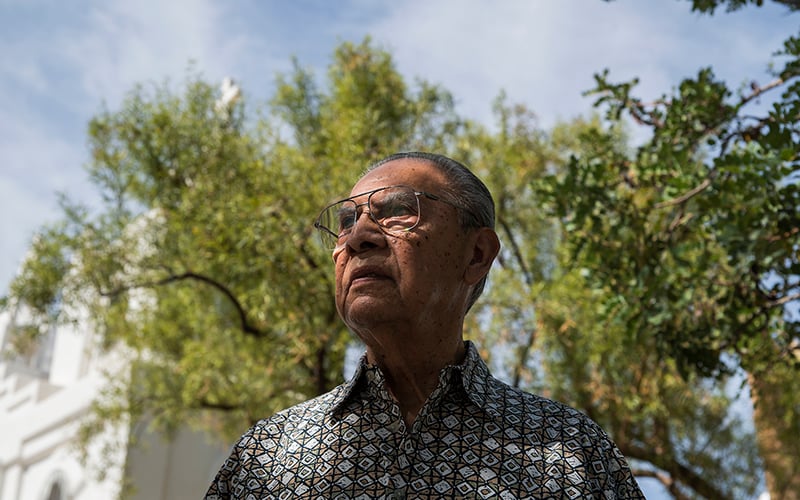WASHINGTON, D.C. – Andrea Montes turns 18 just weeks before the November election, and the Wisconsin resident plans to vote for the first time.
Editor’s note:
This story was produced by the Walter Cronkite School-based Carnegie-Knight News21 “Voting Wars” national reporting project.
She said she had always planned to exercise that right, but an incident in April made it clear just how important it was to cast her ballot. Montes was playing in a high school soccer game when it turned ugly. Fans on the opposing team began yelling “Trump ’16” and “Build that wall” at her Latina teammates, she said.
“The candidates this election aren’t the best,” Montes said. “But I feel like if I don’t vote, it means that I’m OK with Donald Trump leading the country. And I’m not. People of color need to be voting this election.”
The soccer incident made national headlines, and Democratic presidential nominee Hillary Clinton even brought it up during a speech at the League of United Latin American Citizens conference in Washington, D.C. It’s exactly the kind of experience experts say might help galvanize the Latino electorate to vote this November.
Organizations like Univision, Voto Latino and the Southwest Voter Registration and Education Project have tried to capitalize on the momentum, and the groups have spent months knocking on doors, sending text messages and blasting the airwaves to register Latinos. One expert said he expects a “mad frenzy” of voter registration leading up to the election.
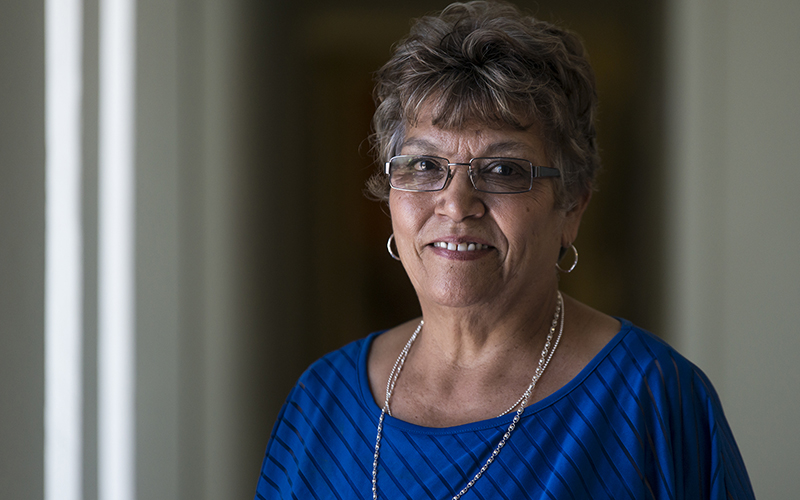
Gloria Torres serves as a city councilwoman and school board member in the border town of San Luis, Arizona. (Photo by Roman Knertser/News21)
Yet, it’s unclear whether Latinos will turn out. If they do, they have tremendous potential to affect the outcome.
The Latino population has jumped from 4 percent of the country’s population in 1965 to nearly 20 percent of the population in 2015, according to Pew Research Center. The growth has been steady and noticeable. Today, there are more than 55 million Latinos in the U.S., and an expected 27.3 million will be eligible to vote in November.
But a longstanding gap remains between Latinos who can vote and those who will. The National Association of Latino Elected Officials projects 13.1 million Latino voters will cast ballots this November, which is a 17 percent increase from the last presidential election. But it’s still less than half of the eligible voters.
During the past few presidential elections, national media began to speculate on the effect of the Latino electorate and even gave it the moniker “the sleeping giant.” But every year, despite increased potential, it seemed that giant hadn’t yet awakened.
Indicators suggest this could be the year: Latinos have registered to vote at increasing rates, and many Latino voters indicated they’re more interested in this election – motivated by issues such as the economy and immigration and by Republican presidential nominee Donald Trump’s anti-immigration stance.
“Harsh rhetoric that has been spewed by Donald Trump, right out of the gate, comparing Mexicans to rapists and murderers, could help galvanize the Latino vote to vote against him,” said Joseph Garcia, director of the Latino policy center for the Morrison Institute for Public Policy at Arizona State University, which researches and analyzes critical issues in the state.
At the same time, several factors may keep Latinos away – or at least prevent the electorate from reaching its full potential – this November. Candidates have largely neglected this segment of the population. States have implemented new voting restrictions, creating barriers for both registration and voting. And millennials, who tend to stay away from the polls, make up nearly half the eligible Latino electorate.
More than 60 percent of the nation’s Latinos have a high school education or less. And almost a quarter live in poverty. Voters who are young, poor and less educated don’t vote in large numbers, Garcia said.
No one can say for certain when Latino voter turnout will surge, but Garcia said it eventually will. “(This election) will be the last gasp when it comes to how you can totally disregard an entire ethnic group of voters,” Garcia told News21.
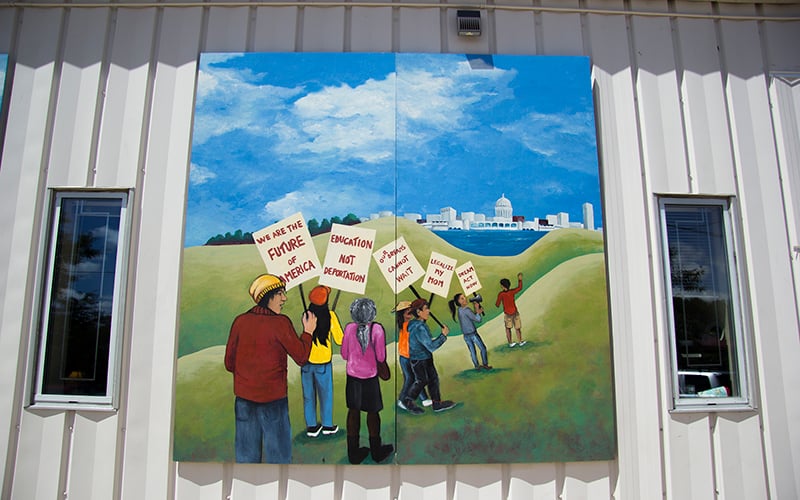
A mural outside of Centro Hispano, a Latino community center in Madison, Wisconsin, captures the unrest of the modern generation of young Latinos – a generation calling for programs like immigration reform. Latino-oriented get-out-the-vote campaigns often aim to channel the potential of these young voters, who make up much of the Latino electorate. (Photo by Sami Edge/News21)
Latinos play critical role in nation’s economy
On Feb. 18, protesters crowded the Wisconsin Capitol in Madison during a movement they called “Dia Sin Latinos” – a day without Latinos.
Latino business owners, employees and advocates were protesting two bills – one of which would prevent voters from using a city-issued ID to vote. Organizers of the movement encouraged Latino workers to skip work and join the crowd at the Capitol or stay home to prove how much the state’s economy relies on Latino workers.
Benjamin Marquez, a professor of political science at the University of Wisconsin-Madison, called the protest a success based on the sheer size of the rally. An estimated 20,000 people showed, according to WMTV, an NBC affiliate.
Marquez described Wisconsin as a “frontier state” because of the influx in Latino population. In the 10 years after 2000, Wisconsin’s Latino population grew 74 percent, according to U.S. Census data.
Joseph Statz, an owner of the Statz Bros dairy farm in Sun Prairie, Wisconsin, said his 4,000-cow-milking operation couldn’t exist without Latino workers. His 110 employees mix feed, scrape stalls and lay fresh bedding for the cows. And most importantly, they milk the cows. At least two-thirds of his workers are Latino, he said.
“They’re the ones who come and apply for the jobs,” Statz told News21. “It would be hard for a lot of people to exist if it wasn’t for them. We need to help them – whatever it’s going to take to get them to stay.”
Latinos make up about 16 percent of the American workforce, according to statistics from the U.S. Bureau of Labor Statistics. They hold more jobs in agriculture, construction and maintenance than any other group.
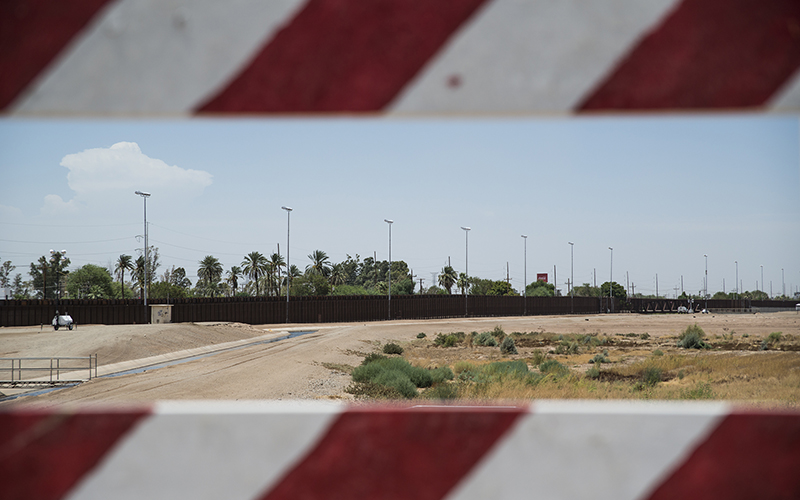
More people work in agriculture than any other industry in San Luis, Arizona. (Photo by Roman Knertser/News21)
Yet, Hispanics earn less than other workers. Over a 12-month period, Hispanic workers earned about $10,400 less than full-time workers in other racial groups, according to a 2013 report by the U.S. Congress Joint Economic Committee.
And that may speak to the need for Latinos to exercise their voice in the political spectrum.
Latinos have repeatedly cited economic matters as the most important issue when it comes to voting. For example, more than 71 percent of Latino voters said they want the next president to support increasing the minimum wage from $7.25 to $15, according to a February poll among 1,200 voters conducted by Noticias Univision and The Washington Post.
Experts predict tight races in states such as Florida, Nevada and Colorado this November. According to Pew numbers, Latino voters make up 15 percent or more in those three battleground states – so Latino turnout could prove the strength of the voting bloc there.
Experts: Cynicism, unfamiliarity keep Latinos from polls
Alma Marquez, founder and president of a communications and public affairs firm that focuses on education-related issues and political and civic engagement, said Latinos are often portrayed as apathetic because of their low voter turnout.
But some Latino voters and experts said it’s not apathy: They do care about politics and understand the importance of civic engagement. They said other factors keep Latinos away from the polls, including cynicism, unfamiliarity with voting and language barriers.
“Many of the community members feel as though they’re not really viewed as Americans,” Marquez said. “And so there’s this logic, ‘If I’m not really viewed as American or respected as American, then why should I (vote)?'”
Other Latino voters, like Sabino Nañez, 34, said Latinos will vote “when they feel like they are first-class citizens” instead of third-class citizens.
The Milwaukee resident said when the U.S. Supreme Court blocked President Barack Obama’s expansion of Deferred Action for Childhood Arrivals and Deferred Action for Parental Accountability in June – which would have given parents of U.S citizens legal presence – it discouraged the Latino community even more.
History suggests why Latinos may feel this way. Since the U.S. took ownership of former Mexican territories in 1848, Mexican-Americans have faced discrimination. The vast majority of Mexicans living in the territories became U.S. citizens, but they earned lower wages than their white counterparts. Many could not buy real estate. Mexican-Americans were not allowed to learn English, which disenfranchised them. And some places denied Latinos the right to vote by creating white-only primary elections, according to LULAC.
David Castorena told News21 that disillusionment will keep him from voting. The 24-year-old Guadalupe, Arizona, native voted for Obama in 2012, but he said he won’t vote in this election. “I just don’t think my vote matters,” he said. “Trump is going to win anyway.”
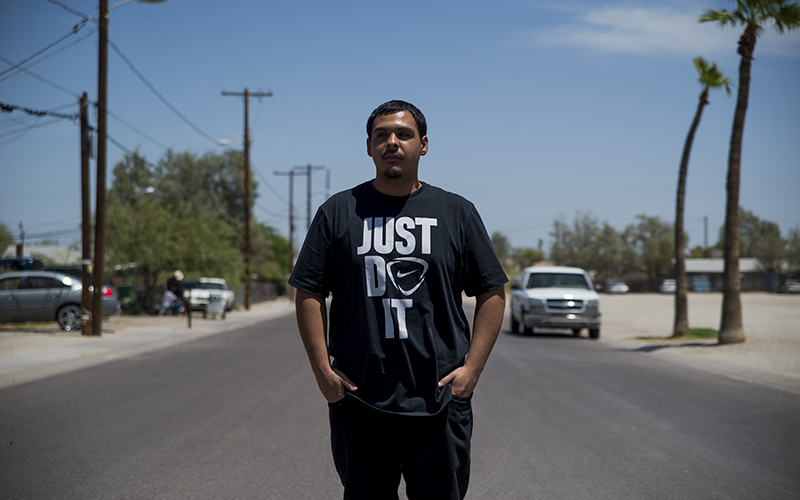
David Castorena, 24, of Chandler, Arizona, stands in the street of a small, largely-Latino community where he attends church. Castorena said he does not plan to vote in the upcoming November Election because he thinks that Donald Trump will win either way. (Photo by Roman Knertser/News21)
Marquez said she remembers going with her mother to vote at the neighborhood fire station in southeast Los Angeles when she was young. Her mother, a staunch Democrat, voted in every election.
It was clear to Marquez, now 42, that voting was important, especially when members of the community who were immigrants could not voice their concerns.
“It was always the sense that this is our responsibility,” she said. “We have to vote because we’re voting for not only our family and our community, but for other people who do not have the privilege of voting.”
However, many Latino families don’t have that same history of voting, so voting isn’t necessarily familiar to them, she said.
“Going to the voting booth is intimidating especially if you don’t know how to do it,” Marquez said. “And it’s actually quite embarrassing to show up at any age, and tell people ‘I don’t know how to vote.'”
Language barriers still pose issues when voting
About 15 percent of Latinos speak limited English, according to data from the U.S. Census.
If limited-English speakers make up more than 5 percent of a community’s population, among other requirements, federal law requires those communities to provide bilingual election materials and allow translators at the polls.
Salem, Massachusetts, is one of those communities that doesn’t meet the federal requirement.
The Hispanic population just about mirrors the nation as a whole at about 16 percent, and the majority of those residents speak English well.
Inside the Point neighborhood, which is less than half a square mile of Salem, nearly 65 percent of residents are Hispanic, and 20 percent of households don’t speak English. The residents are mostly immigrants from the Dominican Republic. The smell of pastelitos wafts from corner-store colmados, and the lilt of island-Spanish rings through the streets.
Neighborhood advocates said the language barrier has proven problematic for voters.
Staffers at the North Shore Community Development Coalition, a neighborhood nonprofit, launched registration and voter education efforts around 2010, after residents said they’d had difficulty voting. They trained as poll watchers to keep an eye out for problems.
In both 2012 and 2014, coalition members say they saw and heard about problems at the polls.
Latino voters said election workers prevented them from voting because they couldn’t communicate and that police took bilingual sample ballots away from the voters. One translator, who works for the nonprofit, said police officers held her in a room because she was disturbing the voting process by asking voters if they wanted help. And coalition members said scores of Latino voters were asked for ID when white voters weren’t.
Massachusetts doesn’t have an ID law, per se, but the state allows poll workers to ask for ID from new voters, voters who are inactive or if the poll worker has “reasonable suspicion” about a voter.
“It was just so hard,” said Rosario Ubiera-Minaya, a coalition staff member. “They’re putting (Latino citizens) in a position where they have to advocate and fight just to cast a vote.”
Since the last election, community leaders and residents of the Point have brought their issues to the Salem City Council, and they said relations are improving. The mayor and the police chief have agreed to work with Latinos to increase access at the polls.
But the Salem city clerk, who runs elections, refused to sign a memorandum they drafted asking for extra training for poll workers and more bilingual resources, among other things.
“I can’t single out a single group of people,” Clerk Cheryl LaPointe said. “I will never sign anything that isn’t for the good of all voters.”
Candidates seldom target Latino voters
Experts said candidates often ignore Latinos as a voting bloc.
Campaigns and political groups often base their voter outreach efforts on certain attributes, such as voting history and economic status. A Stanford University study found that 1 in 5 Latino voters is “unlisted” on the target lists, while more than 90 percent of white voters are listed.
“If we continue the practice of ignoring those voters, we not only prevent robust Latino turnout in election 2016, but we also don’t promote a sustained participation by Latinos and other underrepresented groups in our electoral process,” said Rosalind Gold, director of policy, research and advocacy for the National Association of Latino Elected Officials, or NALEO.
Sergio Arellano, the field director for Hispanic initiatives for the Arizona Republican Party, said Latinos have not only been disenfranchised by the GOP, the Democratic Party has neglected them as well.
“The Republican Party bought into the narrative that Hispanics are Democrat, so for the longest time, people have just let that stand and fall to the wayside,” he said. “When you have a Democratic Party that has free votes, like the ones that the Hispanics provide, the Democrats don’t have to do any engagement in the communities either.”
At this year’s Republican National Convention, several elected officials said they didn’t want to discuss issues that relate more to certain ethnic groups. They said separating the electorate into racial groups was unproductive and unpatriotic.
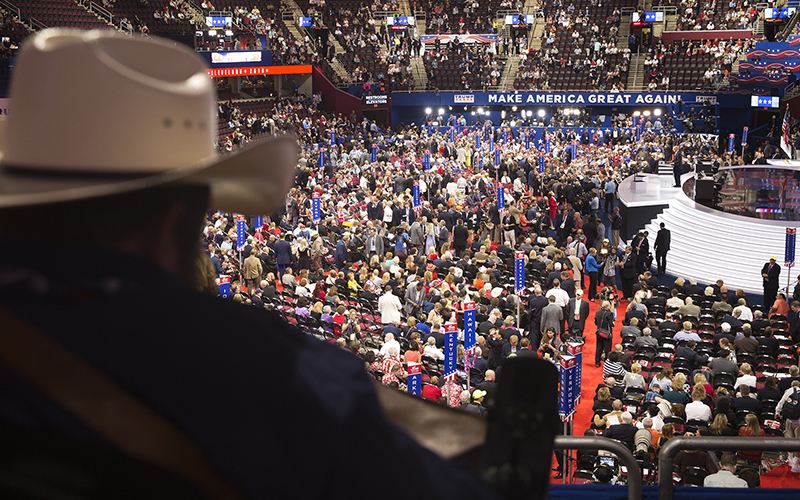
The Latino Coalition held an event during this year’s Republican National Convention. (Photo by Emily Mahoney/News21)
“I’m not a big fan of identity politics,” Arizona Gov. Doug Ducey said. “I think of our citizens as Americans, and I try to look for issues that attract them to our party.” He added that his platform focuses on the economy and education, which appeals to all citizens, regardless of background.
Traditionally, Latinos vote more heavily Democratic than Republican. But that’s been changing, and more Latinos have listed no party preference.
Two years ago, the Republican National Committee created positions, including Arellano’s, to reach Latino communities in key states with majority-minority representation.
This summer, Trump hired the “Latinas for Trump” founder as Latino outreach director for his campaign. And Clinton hired the president of the Latino Victory Project, a group with a mission to get more Latinos politically engaged, as her deputy director of voter outreach and mobilization.
Garcia, of the Morrison Institute, said it’s not just about making appearances, it’s important that party platforms change to include Latino issues, such as immigration reform, education, raising the minimum wage and health care.
“It’s easier to mobilize around an issue or a cause particularly if it’s an issue or cause that Latinos feel hurt them in general,” said Stella Rouse, associate professor and director of the Center for American Politics and Citizenship at the University of Maryland.
New laws pose new problems
Some legislative requirements for voter registration and photo voter identification at the polls also may limit Latino voting.
NALEO indicated that nearly 8 million eligible Latino voters across the nation live in places that used to be covered under a key provision of the Voting Rights Act that had required states and jurisdictions with a history of discrimination to obtain U.S. Department of Justice pre-clearance before making voting changes. The U.S. Supreme Court struck down the provision in 2013.
NALEO projects 875,000 Latinos may have a harder time voting this year because they live in the 20 states that approved or implemented new voting restrictions since 2012, according to a News21 analysis. Many of these policy changes have been challenged in court, and even overturned, creating uncertainty over what rules will be in place by November.
“Latinos are one of these groups hit the hardest by (the) strongest voter ID laws,” Rouse said. “These laws target people who don’t speak the native language, don’t have the resources, don’t have the proper ID, who are poor (and) don’t have the transportation to get that ID. Latinos, just like African-Americans, the elderly, the rural communities, fit into those groups that really create obstacles for voting.”
Across the U.S., 13 percent of African-Americans and 10 percent of Hispanics do not have proper photo ID, while only 5 percent of whites lack the proper ID, according to Project Vote, a nonpartisan, nonprofit voter advocacy organization.
Arizona recently passed a law that criminalizes ballot collecting, a method used by nonpartisan organizations and mostly Democratic campaigns to ensure people in low-income, minority communities cast their mail-in ballots. Campaigns and advocacy groups travel through these neighborhoods to collect marked ballots and return them to elections officials.
The law, signed in March, makes it a felony for anyone other than household members, family members or caregivers of voters to collect and turn in the ballots.
Tony Valdovinos has done voter outreach in Latino neighborhoods in Phoenix for the past six years. He called the new law “a voter suppression bill” because local organizations have made ballot collection a part of their get-out-the-vote efforts for years.
The Democratic National Committee filed a lawsuit and asked the U.S. District Court for an injunction to block the law from taking effect.
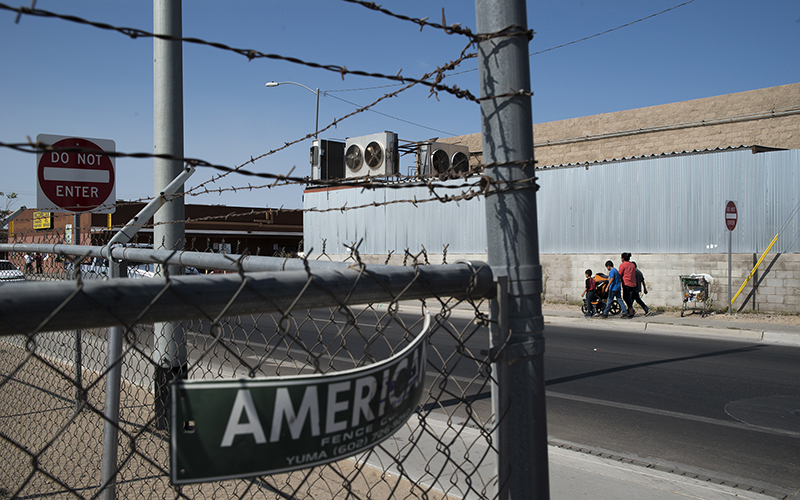
A total of 15.8 million people passed through the border crossing in San Luis, Arizona, in 2015. (Photo by Roman Knertser/News21)
The lawsuit named the communities of San Luis and Somerton on the U.S.-Mexico border, saying residents there must pick up their mail at the local post offices. Rogelio Torres, who works at a nongovernmental organization in Somerton that serves farmworkers, told News21 in Spanish that in these majority Latino communities, ballot collection had made it easier for elderly people without their own transportation to vote by early ballot.
Yuma County Supervisor Marco Antonio Reyes said the law turns something that would be considered normal into something sinister.
But Robert Graham, chairman for the Arizona Republican Party, said the law protects voters. Ducey added that it’s easy to vote in Arizona, and the new law won’t cause any problems. He said the state makes it “easy to vote and hard to cheat.”
Arellano said that “cheating” happens when organizations offer monetary rewards to volunteers who collect the most ballots.
“Now the incentive isn’t to help the poor old nana or the poor old Mr. Flores,” he said. “The incentive now is to get that ballot and get paid at all costs.”
However, Reyes said he has yet to see one instance of voter fraud related to ballot collection and hasn’t heard any complaints from voters.
Organizations attempt to reach potential voters
In February, Univision, the leading Spanish-broadcasting network, announced its goal to register 3 million Latino voters before November.
Univision is the fifth-largest network in the U.S. and plays an essential role in providing Spanish-language news and entertainment to the Latino community. Univision partnered with organizations on national and local levels to promote the effort.
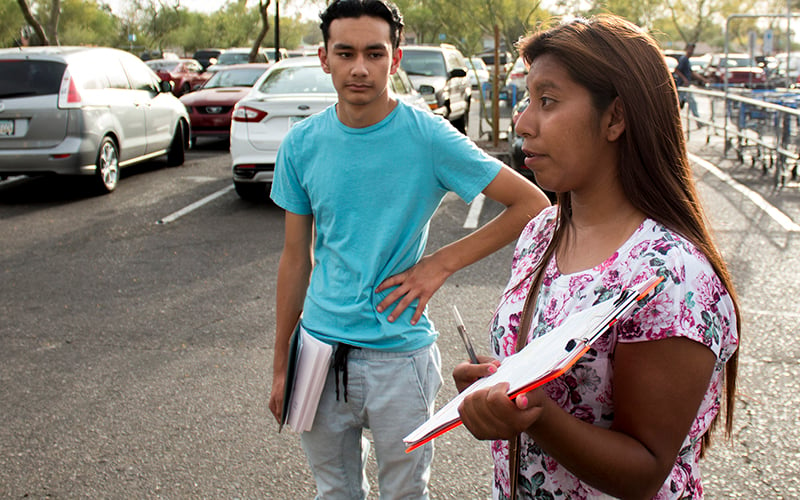
Yenni Sanchez, 18, has registered people to vote for three years. She said that she registers as many people as she can because she isn’t eligible to vote. Daniel Flores, 16, is also a volunteer. (Courtney Columbus/News21)
This year, the company created the Your America website, which allows people to sign up for text message updates about the election. And more than 100,000 people attended forums and registration drives that Univision hosted across the country.
Antonio Gonzalez, president of the Southwest Voter Registration and Education Project, said he expects the gap between the number of eligible Latino voters and actual voters to decrease. However, he said, it always gets smaller in presidential cycles. Gonzalez said to expect a “mad frenzy” of voter registration that will drive the number of registered Latino voters from 14 million in 2012 to 16 million by November, but it could grow even higher if the two main political parties prioritize resources to register Latinos.
Voto Latino, which began in 2004, is trying to engage younger Latinos. The group developed a mobile app called VoterPal that allows users to register to vote on their smartphone and register their friends and family as well. Mario Carrillo, Voto Latino’s communication director, said the majority of young Latinos read their information in English and online, so that’s where Voto Latino focuses on reaching them.
What happens when Latinos reach the majority?
Census population projections suggest that in 2044, the U.S. will become a majority-minority nation with Latinos making up almost a quarter of the entire population.
In California, at 39 percent of the state’s population, Latinos make up a larger portion of California than whites.
“Latinos have always been a big population here, but they weren’t always a voting population,” Gonzalez said. “They became one. They realized they needed to become a voting population in order to have better lives.”
The state has 1,377 Latino elected officials, and 34 of them serve at the state and federal level, according to NALEO’s directory of Latino elected officials.
In Los Angeles, almost a quarter of employees in management, business, science and arts occupations are Latino. Nationally, only 17 percent of those occupations are held by Latinos.
Gonzalez said the Latino community in Los Angeles is deeply rooted.
“We’ve been here 10,000 years,” he said. “We have a large presence in institutions, universities, churches, business and government.”
Gonzalez said California’s Latinos, specifically in Los Angeles, had a breakthrough in the 1980s and 1990s sparked by an acrimonious period of racism and struggle. He said the Latino population had to become organized and do “blood, sweat and tears work.”
“You have to run the candidates and lose and do the (lawsuits),” he said. “You have to break through.”
Although many groups have focused their efforts on spurring those changes, some of it will happen naturally as the Latino population ages.

Alejandra Campos, 23, a native of Somerton, Arizona, has never registered to vote. Campos does not believe in the political system. She says politicians only make promises. (Photo by Roman Knertser/News21)
Millennial voters make up a larger share of the Latino electorate than they do any other ethnic group. Research predicts this trend will continue.
Montes, the 17-year-old from Wisconsin, is just one of the 3.2 million Latinos who have, or will, turn 18 in time for the 2016 election, according to Pew numbers. She is the face of the future Latino voter.
Montes is U.S.-born, much like most other Latinos (only a quarter of the Latino electorate is foreign-born). Montes’s father came to America from Guanajuato, Mexico, as a teen looking for work. He later brought his wife to Beloit, Wisconsin, where they raised Montes, her older brother and sister.
Her father became a citizen six years ago, and her mother followed suit two years later.
And Montes is eager to vote.
Pamela Ortega contributed to this report.
